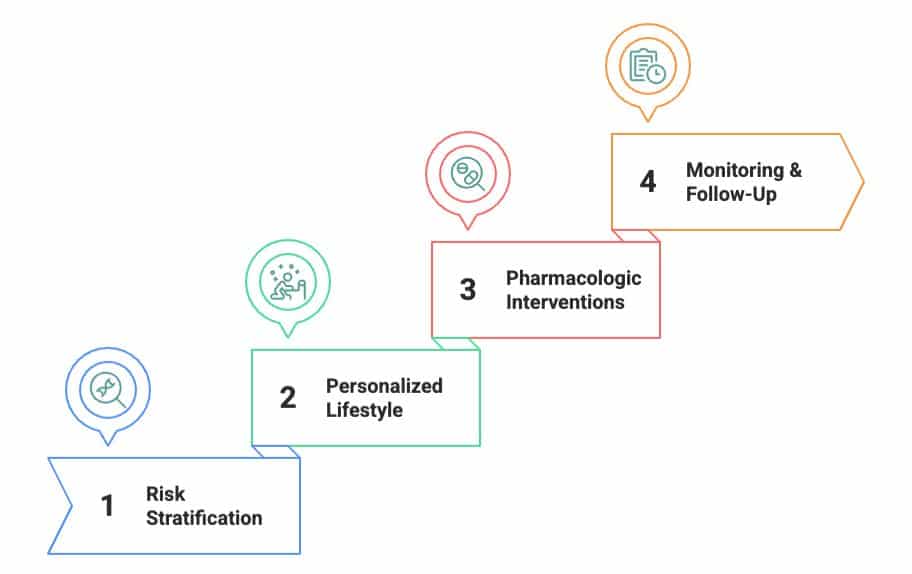What if your patient’s age had less to do with the calendar and more to do with methylation?
Epigenetics is reshaping how we define risk, resilience, and recovery. Epigenetics is the study of reversible, heritable changes in gene expression that occur without altering the DNA sequence. These molecular “switches” respond to environmental and lifestyle signals, offering healthcare professionals powerful opportunities for targeted prevention and intervention.
Epigenetic Mechanisms: Clinical Essentials
The three primary mechanisms of epigenetic regulation include:
| DNA Methylation | Histone Modifications | Non-coding RNSs |
| DNA methylation silences gene expression by adding methyl groups to CpG sites. | Histone modifications (e.g., acetylation, methylation) alter chromatin structure to activate or repress transcription. | Non-coding RNAs (miRNAs, lncRNAs, siRNAs) fine-tune gene expression by modulating mRNA stability and chromatin remodeling |
The epigenome acts as a dynamic bridge between genes and environment. Dysregulation in this system contributes to aging, chronic disease, cancer, immune dysfunction, and mental health conditions. For healthcare professionals, understanding epigenetics is essential to explain why similar patients often diverge in outcomes and to guide more personalized, preventive care.
Disease and Aging: The Epigenetic Connection
1. Biological Aging & Epigenetic Drift:
As an individual’s age, epigenetic drift, progressive methylation alterations leads to deregulated gene function. Epigenetic clocks using methylation patterns more accurately assess biological age than chronological age. Clinically, accelerated epigenetic aging correlates with:
- Chronic systemic inflammation and immune senescence
- Metabolic disorders and oxidative stress
- Cognitive decline and tissue frailty
2. Reversibility: Clinical Potential:
One of the most compelling aspects of epigenetics is its responsiveness to modifiable factors. Nutrients such as folate, choline, B vitamins, and polyphenols can support methylation pathways, while physical activity and circadian rhythm alignment have shown favorable impacts on gene expression.
The Reversal of Biological Age: A Clinical Example:
As demonstrated in the clinical trial (PMC8064200), the following 8-week multi-domain intervention led to a reversal of biological age by over 3.23 years in men and 4.6 years in women:
| Category | Intervention Details |
| Dietary Prescription | Weekly Targets: – 3 servings liver (3 oz each), organic preferred- 5–10 eggs, free-range, organic, omega-3 enriched. Daily Targets:– – 2 cups dark leafy greens (e.g., kale, spinach, chard) – 2 cups cruciferous vegetables (e.g., broccoli, cabbage, Brussels sprouts) – 3 cups colorful non-starchy vegetables (excluding white potatoes, sweet corn) – 1 to 2 medium beets – 4 tbsp pumpkin seeds (or pumpkin seed butter) – 4 tbsp sunflower seeds (or sunflower seed butter) -1+ methylation adaptogen: choose from: 1. ½ cup wild berries 2. ½ tsp rosemary or turmeric 3. 2 cloves garlic 4. 2 cups green tea (steeped 10 min) 5. 3 cups oolong tea (steeped 10 min) -6 oz high-quality animal protein, grass-fed, pastured, hormone- and antibiotic-free -2 servings low-glycemic fruit. |
| Supplement Protocol | -2 capsules/day (Lactobacillus plantarum 299v) -2 servings/day (combination of organic fruits, vegetables, herbs, enzymes, prebiotics, probiotics) |
| Exercise Prescription | – ≥30 minutes/day – Minimum 5 days/week – Moderate intensity (60–80% perceived exertion) |
| Sleep Prescription | – Average ≥7 hours of sleep per night |
| Stress Management | – Relaxation Response technique by Dr. Herbert Benson – Practice breathing exercises twice daily |
The results were striking: the intervention group experienced an average 3.23-year reduction in biological age, measured via the Horvath DNA methylation clock. A follow-up case series in women using the same protocol showed a 4.6-year biological age reversal over the same time period.
Clinical Application Example
Consider a 58-year-old male patient with no overt disease but a history of sedentary behavior, borderline fasting glucose, and persistent fatigue. Traditional risk assessments may not flag him as high-risk, yet biological age testing reveals he is aging biologically 6 years faster than his chronological age.
Using the above intervention protocol as a model, healthcare professionals could prescribe a personalized 2-month plan targeting diet, movement, stress, and sleep.
By retesting biological age post-intervention, healthcare professionals can measure real, trackable improvements in epigenetic aging offering a powerful motivational tool for the patient and a measurable, outcome-driven strategy for the provider.
3. Clinical Application: A Roadmap for healthcare professionals
1. Risk Stratification & Diagnosis:
Use epigenetic clocks and methylation markers to identify patients with accelerated aging or unexplained chronic conditions.
2. Personalized Lifestyle Prescriptions:
Recommend targeted nutrition, exercise, stress management, and sleep strategies to influence epigenetic expression.
3. Pharmacologic Interventions:
Consider epigenetic therapies where appropriate, and monitor for unintended epigenetic effects from standard medications.
4. Monitoring & Follow-Up:
Track biological age, homocysteine, and inflammatory markers to assess intervention outcomes over time.

At ExtendingMe, our epigenetic panel assess gene regulation related to vision, brain function, and immune aging equipping healthcare professionals with actionable insights for precision-based preventive care that addresses dysfunction at its root.
Reference:
- https://www.ncbi.nlm.nih.gov/books/NBK532999/
- https://www.nature.com/scitable/topicpage/epigenetic-influences-and-disease-895/
- https://pmc.ncbi.nlm.nih.gov/articles/PMC8064200/
- https://pmc.ncbi.nlm.nih.gov/articles/PMC5168835/#:~:text=in%20AMD%20patients.-,Cataract,modalities%20for%20age%2Drelated%20cataracts.
- https://www.sciencedirect.com/science/article/abs/pii/S1084952122002701
- https://pubmed.ncbi.nlm.nih.gov/33401659/
